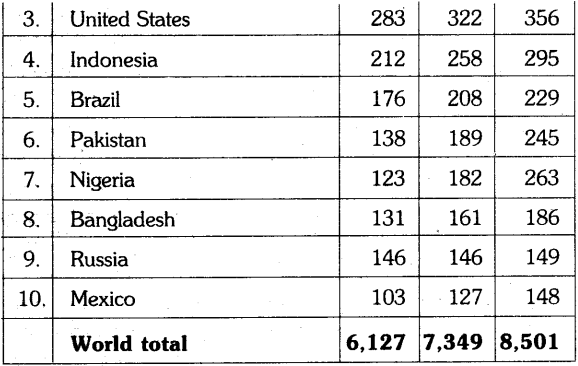Telangana TSBIE TS Inter 1st Year Environmental Education Study Material 3rd Lesson Population Explosion and its Consequences Textbook Questions and Answers.
TS Inter 1st Year Environmental Education Study Material 3rd Lesson Population Explosion and its Consequences
Easy Questions
Question 1.
What is population? Write briefly about population explosion and causes of population explosion.
Answer:
Introduction :
Population is a group of individuals of a particular species, sharing a common gene pool and occupying a particular area at a specific time.
Population Explosion refers to the sudden and rapid rise in the size of population, especially human population. A drastic growth in population beyond normal limits is called population explosion. Population explosion is a global phenomenon but is more prominent in under developed and developing countries. The population of the world currently (May 2018) is about 7.6 billion. While China is the most populous country with over 1.38 billion inhabitants, it is predicted that India will overtake China by 2025. India and China together account for about 37% of the world’s population, Given below is a list of the world’s most populous countries along with projected figures for 2030.


The causes of population explosion are as follows :
a) Accelerating Birth rate / High Fertility rate :
The Fertility rate of a country refers to the number of children a woman gives birth to during her child bearing age. High fertility rates lead to a rapid increase in the population of a country. High fertility rates are prevalent in countries which are underdeveloped and where literacy rates, especially among women, are low. It is not a coincidence that 9 out of the 10 top countries with the highest fertility rates are in Africa, a continent in which the inhabitants of several regions routinely face abject poverty, starvation, famine, drought and disease, besides internal strife. Nigeria, a country in Africa, has the world’s highest fertility rate. On an average, women in Niger give birth to 7 children each. In India, the fertility rate is 2.2. Bihar, one of the most backward states, has the highest fertility rate of 3.34. Telangana has a fertility rate of 1.78.
b) Decrease in Infant Mortality Rate :
Infant Mortality Rate refers to the number of deaths of infants under 1 year old per 1000 live births. An improvement in medical science and technology, better maternal care facilities and wide usage of preventive drugs (vaccines) has reduced infant mortality rates in many countries, including India. 1MR is an index of the health of a country. Monaco, Japan, Iceland and Singapore are countries with an IMR of less than 2.5. The IMR in India (as>in 2016) is 34.
c) Increase in life expectancy :
Due to improved living conditions, better hygiene and sanitation habits, better nutrition, health and education, the average life expectancy of human population has improved significantly. Steady supply of good quality food, makes sure that the population is well nourished. Population grows when they are adequately nourished. Japan, Switzerland and Singapore have the highest life expectancies in the world, with an average life expectancy of about 83 years. The life expect^npy in India is about 68 years (as in 2015).

d) Increased immigration :
An increase in immigration Often contributes towards population explosion, particularly in developed countries. It happens when a large number arrive at an already populated place with the intention to reside permanently.
e) Less space than required :
In urban cities, it is often found that there is very less scope for making available extra space to absorb the additional population. In such cases, a large population is seen packed into a smaller space.
The details of the Indian population density and age distribution are given in the map :

![]()
Question 2.
Explain the consequences of population explosion.
Answer:
Consequences of Population Explosion :
i) Over Exploitation of Natural Resources :
Due to high growth in population, the requirements of the people have increased at a tremendous rate. Consequently, the available natural resources are getting depleted. The Earth has limited natural resources like water, land, flora and fauna, minerals and fossil fuels. Over-exploitation has created a severe depletion of resources. Humans today extract and use around 50% more natural resources than they did just 30 years ago. It is estimated that within 40 years, the reserves of petroleum will vanish completely. Water scarcity is rampant and it is common for states to be engaged in bitter disputes about their rightful share of water.
ii) Industrialization and Urbanization :
Urbanization is the result of growth of population in urban areas. As a country develops from primarily an agricultural to an industrial economy, large – scale emigration of rural residents to towns and cities takes place. During the process, the growth rate of urban areas is typically double the pace of overall population increase. Urbanization is taking place at a fast rate in India. The population residing in urban areas in India, according to the 1901 census, was 11.4%. This count increased to 28.53% according to the 2001 census, and in 2018 it stands at 33.2%.
Urbanization eventually leads to a severe decline in the number of people living in the countryside, with negative population growth rates in rural areas. Urban areas face acute shortage of land and water and other environmental problems. Vast areas are converted into slums.
iii) Shrinking Agricultural Land :
Agricultural lands are being converted into residential settlements and industrial zones. The per capita availability of land for cultivation declined by nearly 50% from 1.1 acres in 1911 to 0.6 acres in 1971 in India. Since then it has shrunk much further. The small size of holding hinders adoption of modem technology in farming.
iv) Global Wanning :
Population explosion is linked with global warming. The increase in population leads to greater consumption of resources. The amount of carbon dioxide and other greenhouse gases that is produced increases. This causes a rise in global temperatures. The global average surface temperature has increased during the 20th century by about 0.6°C. If it rises further, the consequences will be disastrous.
v) Environmental Pollution :
The tremendous growth in population has led to the degradation of the environment. Air, water and soil have got contaminated with various pollutants.
vi) Poverty, Malnutrition and Famine :
Millions of people live in hunger and suffer from malnourishment because they cannot afford to buy enough food, cannot afford nutritions food or cannot afford the arming supplies they need to grow enough good food of their own.

Poverty and malnutrition are a common phenomenon in underdeveloped countries. Africa, which has the highest population growth rate, is also the world’s poorest continent. Countries in Sub-Saharan Africa suffer from frequent droughts and famines and have high rates of starvation deaths.
vii) Population reduces the Rate of Capital Formation :
In underdeveloped countries, due to high birth rates and low life expectancy, the number of dependents in families is high. Nearly 40 to 50 per cent of the population is in the non-productive age group, which simply consumes and does not produce anything. The per capita income is low because the dependents have to be fed and taken care of. Job opportunities too are less in poor countries. Thus, there is very little scope for savings or capital formation.
viii) Population growth weakens Social Infrastructure :
In welfare states like India, the government pledges to meet the social needs of the people by providing basic facilities like free or subsidised education, housing and medical aid. But the vast increase in population casts a heavy burden on the government and details many plans.
![]()
Question 3.
Explain population control measures or initiatives in India.
Answer:
Population Control Measures / Initiatives in India :
There are no easy solutions to the problem of population explosion. Population growth is inextricably linked with factors like poverty and illiteracy. It is only when people are educated and enjoy reasonably good standards of living that the population of a country will stabilize. It is not a coincidence that countries like Norway, Switzerland, Singapore and the U.S.A which have a high Human Development Index have a low growth rate of population. In India, economically backward states like Bihar, U.P and Rajasthan have the highest birth rates. A multipronged effort is needed, therefore, to tackle the problem of population explosion.
In countries like India, societal norms and prejudices influence the size of families. The preference for a male child, prevalence of child marriages and the low status accorded to women in many communities are some factors which contribute to high birth rates.
India was the first country in the world to launch a nation wide Family Planning programme in 1952. Government agencies and institutions were mobilized to spread the message of the importance of having small families. The media was extensively used for propaganda. People were reminded of the advantages of small families. It was pointed out that children in such families would be healthy and happy as parents could devote more time and resources to them. Cheap contraceptives were distributed in even the most remote villages, sex education was popularized, sterilizations were conducted and aborption was legalized. Couples were persuaded to go in for sterilization after the birth of two children.
Every country must devise its own ways to tackle the menace of over population. In 1979, China started the ‘one child per family’ policy. Draconian measures were used to implement the law. Those who defied the law and had a second child were subjected to brutal punishment. The child too bore the brunt as the government denied him/her education and health care. The infamous population control measure was successful in bringing down the birthrate but at the cost of gross human rights violations. Such coercive tactics to enforce birth control are abhorrent and are ill-suited for a democratic country like India.
Measures to Control Population :
- The government should regularly conduct programmes to educate the public about the ills of over population.
- Social organizations and NGOs should actively inform people about the available methods of family planning.
- People should be persuaded, but not coerced, to undergo sterilization after having two children.
- Female literacy should be encouraged so that women can take informed decisions about the size of their families.
- The ban on child marriages should be enforced strictly.
- Maternal and childcare facilities should be improved.
Are there any advantages of High Population Growth?
An increase in the rate of population growth is not devoid of advantages. The teeming population of youth in developing countries like India can play a vital role in building the economy. Their strength and talents can be harnessed in various ways. In contrast, advanced countries like Japan and many European countries face peculiar problems associated with a sharp decline in population. Japan has become a society of aging people because of a rapid fall in fertility rates and an increase in longevity. Nearly a quarter of the population is above 65 years. Because of a shrinking labour force, dependence on robots is increasing, both at home and in factories. There is no one to take care of the elderly population.